Unintended pregnancy is common in Uganda, leading to high levels of unplanned births, unsafe abortions, and maternal injury and death. Because most pregnancies that end in abortion are unwanted, nearly all ill health and mortality resulting from unsafe abortion is preventable. This report summarizes evidence on the context and consequences of unintended pregnancy and unsafe abortion in Uganda, points out gaps in knowledge, and highlights steps that can be taken to reduce levels of unintended pregnancy and unsafe abortion, and, in turn, the high level of maternal mortality.
Unintended Pregnancy and Abortion in Uganda

Author(s)
Rubina HussainReproductive rights are under attack. Will you help us fight back with facts?
Key Points
• Abortion is permitted in Uganda under some circumstances, but the relevant laws and policies are unclear and are often interpreted inconsistently, making it difficult for both women and the medical community to understand their options.
• While maternal mortality has declined in Uganda in the last decade, levels remain very high: An estimated 310–438 women die of pregnancy-related causes per 100,000 live births. Furthermore, many Ugandan women suffer severe morbidity, often as a result of unsafe abortion.
• Unintended pregnancy is common in Uganda, leading to high levels of unplanned births. In 2011, more than four in 10 births were unplanned—either mistimed or unwanted. On average, women in Uganda have 6.2 children but only intend to have 4.5 children.
• Adolescents and young adults are particularly at risk for unintended pregnancy. Premarital sex is common in Uganda: More than one in three never-married women aged 15–24 have had sex.
• Contraceptive use remains very low in Uganda. Only 26% of married women and 43% of sexually active unmarried women use a modern method. Furthermore, one in three married women are not using contraceptives even though they do not want to become pregnant.
• Treating complications of unsafe abortion poses significant costs to the Ugandan health system. On average, postabortion care costs nearly US$130 per patient; the annual costs total nearly US$14 million.
Unintended pregnancy is common in Uganda, leading to high levels of unplanned births, unsafe abortions, and maternal injury and death. Because most pregnancies that end in abortion are unwanted, nearly all ill health and mortality resulting from unsafe abortion is preventable. This report summarizes evidence on the context and consequences of unintended pregnancy and unsafe abortion in Uganda, points out gaps in knowledge, and highlights steps that can be taken to reduce levels of unintended pregnancy and unsafe abortion, and, in turn, the high level of maternal mortality.
Uganda, a country of nearly 35 million (including 8 million women of reproductive age), has one of the highest rates of population growth in the world.1–3 Although the economy has improved steadily in the last two decades, poverty remains pervasive; the gross national income per capita (US$510) is less than half the average for Sub-Saharan Africa.1 While Uganda’s population remains mostly rural, women are increasingly moving to urban areas, in many cases to seek work or education and to find opportunities to help their families live a better life.4 In 2011, about 28% of Ugandan women of reproductive age had at least some secondary education, compared with 18% a decade earlier (Table 1, page 2). As women’s opportunities have increased, so have their desires to have fewer children and plan their fertility. However, resource constraints, such as the shortage of providers, limit access to health care and make it difficult for women to meet their reproductive health needs.5
Unintended pregnancy is very common in Uganda
In 2008, an estimated 1.2 million unintended pregnancies occurred in Uganda, representing more than half of the country’s 2.2 million pregnancies (Figure 1, page 3). Such unintended pregnancies result in two main outcomes—unplanned births and abortion.6 According to the 2011 Uganda Demographic and Health Survey, more than four in 10 births (43%) are unplanned (Table 2, page 3).7 The proportion of births that are unplanned is higher among rural, poor and less educated women than among their urban, wealthier and better educated counterparts. Additionally, women in the Eastern and North regions had the highest proportions of unplanned births (50–54%), while the proportions among women living in Karamoja, Kampala and the Central 1 and Southwest regions were lower (12–37%) than the national average.
Table 1

Ugandan women, on average, give birth to nearly two children more than they want—they have 6.2 children but would prefer to have only 4.5 (Figure 2, page 4). This difference between Ugandan women’s total fertility rate and their wanted fertility rate—one of the highest levels of excess fertility in Sub-Saharan Africa8—highlights just how difficult it is for women to meet their fertility desires. The disparity is particularly striking when one compares the fertility rates and desires of women across wealth levels and place of residence. Among women in the highest wealth quintile, the gap between total and wanted fertility is 0.7 children; however, the difference increases rapidly as wealth decreases, with the largest gap among the poorest women (2.3 children). Additionally, rural women, on average have 2.0 children more than they intended, a fertility gap far larger than that of their urban counterparts (0.6 children). There may be several factors that explain the disparity in fertility outcomes, including disparities in access to contraceptive supplies and information as well as socioeconomic and cultural differences among certain subgroups of women.9
Young women are particularly vulnerable to unintended pregnancy
Adolescents and young adults are particularly at risk for unintended pregnancy. Premarital sex is common in Uganda: More than one in three never-married women aged 15–24 have had sex, and nearly one in five unmarried women in that age-group is currently sexually active (Table 1). Moreover, the average age at first sex among women aged 20–24 is about a year and half younger than the average age at first marriage, an age gap that has increased during the last decade. Coercive sexual debut is also common—one study of rural Ugandan secondary students found that 43% of girls who had ever had sex had been "very unwilling" to have their first sexual experience.10 In another study, 20% of women in a rural area of Uganda reported that they had been threatened or forced into having their first sexual experience.11 In such situations, women and girls are less likely to be prepared to negotiate contraceptive use than they are in consensual situations, and therefore are at increased risk for unwanted pregnancy; indeed, the study found that women who had been sexually coerced were more likely than other women to have ever attempted to have an abortion.
Because of the stigma associated with premarital sex, many young people are reluctant to openly seek the family planning services and counseling they need. According to the 2011 Demographic and Health Survey, one of the most commonly cited reasons that unmarried, sexually active young women do not use a contraceptive method is that they are not married, underscoring the impact of the general taboo against sex outside of marriage.7
Premarital pregnancy is also a source of shame, and often results in an array of negative consequences. Some young women are abandoned by their partners, others are forced to leave home and many are expelled from school.12 Although Uganda’s 2004 National Adolescent Health Policy permits girls to return to school after they give birth, resources and support to empower young women to do so are scarce.13
Abortion is permitted under some circumstances, but policies are unclear
The laws and policies surrounding abortion in Uganda are unclear and are often interpreted inconsistently, making it difficult for both women and the medical community to understand their options.14 The Ugandan Constitution allows abortion if the procedure is authorized by the law, but does not state the exact circumstances, leaving room for legal provisions and interpretations. A well-documented 1959 British legal ruling that was incorporated into Uganda’s penal code (British law was the basis for Uganda’s original penal code) addressed the grounds for abortion, which were interpreted to include saving the woman’s life and preserving her physical and mental health. Furthermore, according to the 2006 National Policy Guidelines and Service Standards for Sexual and Reproductive Health and Rights, pregnancy termination is permissible in cases of fetal anomaly, rape and incest, or if the woman has HIV. However, the laws and policies are not clearly detailed in legislation, and because interpretations of the law are ambiguous, medical providers may be reluctant to perform abortion for any reason for fear of legal consequences, even though the penalties do not apply to the provision of legal abortions.
Unsafe abortion is common, but the complication risk varies
The only national estimate of abortion levels in Uganda comes from a 2003 study that employed indirect estimation techniques.15 According to that study, there were nearly 300,000 abortions in Uganda in 2003, which is equivalent to a rate of 54 abortions per 1,000 women of reproductive age, or one abortion for every 19 such women. This rate is far higher than the average rate for Eastern Africa (36 abortions per 1,000 women).16
Women from all socioeconomic and demographic backgrounds have abortions in Uganda. Their experiences, however, may vary considerably. Compared with their poorer counterparts, women who are well off generally have access to a wider range of providers, and are more likely to be able to visit doctors, nurses and clinical officers, some of whom may be trained and able to provide safe procedures.17 However, since abortion is legally restricted in most cases, skilled providers must work in clandestine environments; while they offer confidentiality, they generally charge a high premium for their services.
Table 2
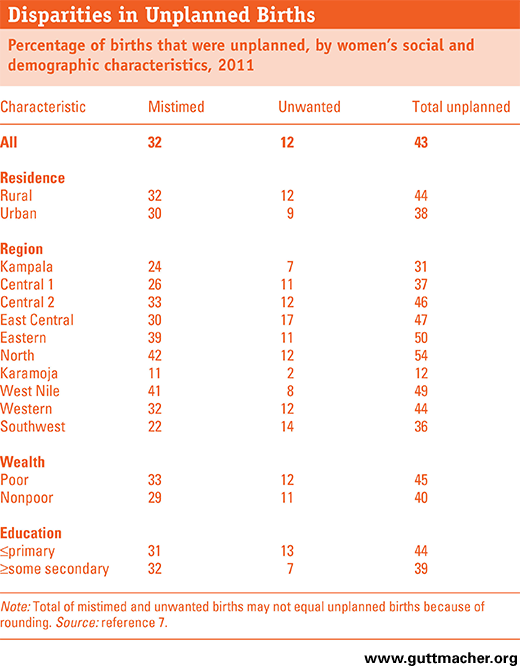
Figure 1
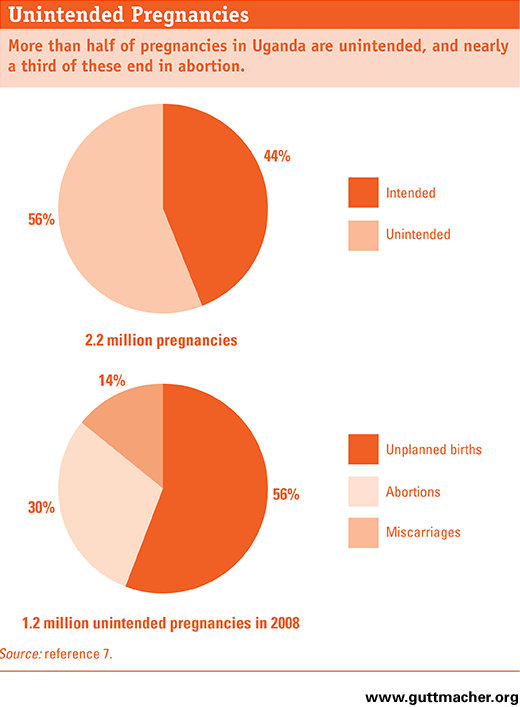
Poor and rural women, whose access to skilled providers is limited by financial constraints and the geographic remoteness of services, often must resort to obtaining abortions performed by untrained providers using unsafe methods.17,18 In one study, Ugandan health professionals estimated that compared to nonpoor urban women, poor rural women were less likely to obtain abortion services from doctors, and much more likely to self-induce their abortions or to use traditional, unqualified providers. Consequently, women who used these unsafe methods had the highest levels of complications: An estimated 68–75% of poor rural women who had had an abortion had experienced complications, compared with 17% of nonpoor urban women who went to a doctor.17
Attitudes toward abortion fuel stigma
Although desired fertility is declining, many Ugandans still want large families and do not approve of abortion.7,8,19 Typically, Ugandan men are the head of the household and want more children than their partners do. One qualitative study found that men generally did not support the practice of abortion because it prevents the birth of a potentially useful member of society.19 Some men said they would not want their partner to have an abortion because they feared the procedure would result in health problems for the woman or legal repercussions for themselves, while others believed that women have abortions to cover up evidence of extramarital affairs. Men did, however, express some support for schoolgirls having abortions.
Other research has revealed that negative views about abortion are pervasive. In another qualitative study, community members acknowledged the deep stigma surrounding abortion and expressed the belief that some healthcare providers mistreat or abuse women seeking postabortion care. In the health professionals study, providers reported that they would rather treat complications of spontaneous abortions (miscarriages) than those of induced abortions, and 53% of healthcare facility staff said they did not approve of modifying the abortion law for any reason.17 Furthermore, policymakers have acknowledged that abortion restrictions endanger women’s lives, but they believed that liberalizing the law could increase the number of abortions and have negative social consequences.20
Unsafe abortion causes serious injury—and sometimes death
While maternal mortality has declined in the last decade, it remains very high in Uganda: Recent estimates suggest that 310–438 women die of pregnancy-related causes per 100,000 live births, and that Ugandan women have a 3% lifetime risk of dying from such causes.8,21 Furthermore, for every maternal death, there are six Ugandan women who suffer severe morbidity, often as a result of unsafe abortion.22 A hospital-based study in Kampala in the early 1990s estimated that 21% of maternal deaths were due to unsafe abortion; in 2008, the Ugandan Ministry of Health estimated that abortion-related causes accounted for 26% of maternal mortality.23,24 The latter figure is considerably higher than the World Health Organization’s estimates for the Eastern Africa subregion (18%) and for the world as a whole (13%).16
Figure 2
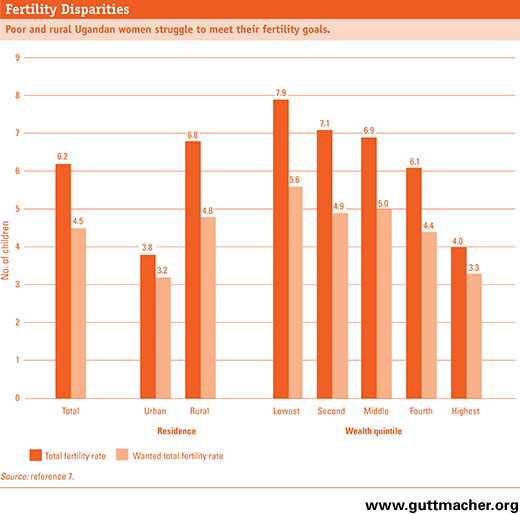
According to the 2003 national incidence study, 15 out of every 1,000 Ugandan women of reproductive age were treated for abortion complications that year.15 Such treatment may require hospital care, blood transfusions and antibiotics—scarce resources in a country with frequent drug stockouts and insufficient medical personnel.25,26 However, the health consequences of unsafe abortion cannot be measured entirely by hospitalization rates, as a substantial proportion of women who need postabortion care do not receive it.17
The costs of abortion and postabortion care are substantial
The amount women pay for a clandestine abortion varies, but much is dependent on what they can afford or access. According to estimates based on the 2003 survey of health professionals, a nonpoor urban woman pays about seven times as much to go to a doctor in a private facility as a poor rural woman pays to obtain services from a traditional or lay practitioner.17 An abortion was estimated to cost a woman US$25–88 if performed by a doctor, US$14–31 if performed by a nurse or midwife, US$12–34 if performed by a traditional healer and US$4–14 if the woman self-induced or used a pharmacist.
A recent study addressed another aspect of the economic impact of unsafe abortion—the cost to the health system of treating complications.27 The researchers estimated costs in the three major types of treatment facilities—regional hospitals, district hospitals and health centers—and found that, on average, postabortion care costs nearly US$130 per patient; in total, such care is estimated to cost nearly $14 million annually in Uganda (Figure 3). Two-thirds of this amount, or US$9.5 million, went to nonmedical costs (overhead and infrastructure), and the remaining third (US$4.4 million) was spent on direct medical inputs (drugs, supplies, labor, hospitalization and outpatient fees). Most of the costs of postabortion care arise from treating incomplete abortion; however a significant proportion can be attributed to more serious complications, such as sepsis, shock, lacerations and perforations.27
Another study, which used a model-based approach, estimated that the average woman pays US$62 per abortion (including any associated postabortion care);28 it also found that each abortion results in US$177 in societal costs—four times the annual per capita health expenditure in Uganda. Findings from these two studies suggest that almost half of the health system cost of treating post-abortion complications is borne by women and their households. In a country where many women live on less than US$1 per day, these costs can have long-term impact on households’ economic well-being.1
Contraceptive use is low, and unmet need persists
The high level of unintended pregnancy and the gap between actual and desired fertility in Uganda can be attributed largely to insufficient contraceptive use. In 2011, only 30% of married women used a method of family planning, a modest increase from 23% a decade before (Table 1).7 Married women’s use of modern (rather than any) methods increased more dramatically, from 14% to 26%, but levels are still too low to reduce the high rates of unintended pregnancy. Among sexually active unmarried women, levels of contraceptive use have been stagnant: In both periods, 43–44% used any method and 38% used a modern method.
Disparities in modern method use among Ugandan subpopulations are considerable: In 2011, only 13–15% of Uganda’s poorest and least educated married women used modern contraceptives, compared with 37–39% of the wealthiest and most educated.7 A greater proportion of urban married women used modern contraceptives than did their rural counterparts (39% vs. 23%).
The proportion of women with an unmet need for contraception—that is, those who either did not want a child soon or wanted to stop childbearing altogether, but were not using any method of birth control—has has remained high during the past decade. In 2011, about one in three married women had an unmet need for contraception (Table 1).7 Most of the unmet need among married women was for spacing or delaying births (62%), but a significant proportion (38%) was for ceasing childbearing altogether. Unmet need varies considerably among subgroups of married women (Figure 4, page 6): Those who are poor, living in rural areas or have no secondary education have much higher levels of unmet need (35–40%) than do their urban, wealthier and better educated counterparts (21–28%).
Additionally, despite their higher levels of contraceptive use, sexually active unmarried women have even greater levels of unmet need than do married women—43% versus 33% (Table 1).7 This may be because unmarried women have a stronger desire not to become pregnant to avoid stigma of pregnancy outside of marriage.
Figure 3
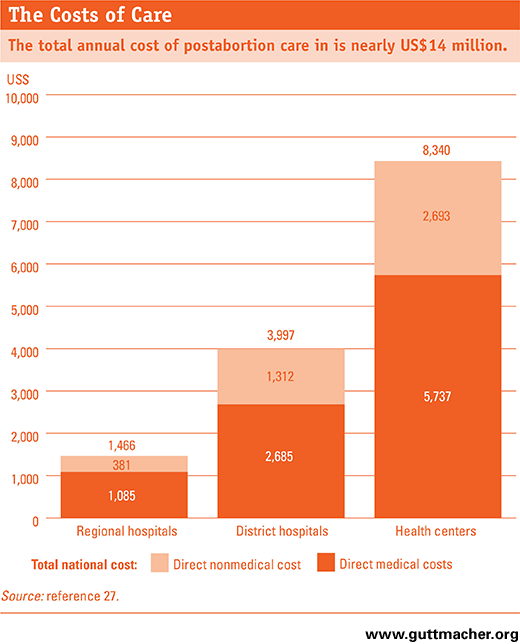
Barriers to contraceptive use
There are many reasons why women do not use contraceptives. Access to services and information can be a barrier: Rural women with an unmet need for contraception are more than twice as likely as urban women to cite lack of access or lack of a source as a reason for not using contraceptives.7 In addition, male partners may discourage or forbid women from practicing contraception. In the qualitative study mentioned earlier, some Ugandan men said they believed contraceptives can cause health problems, such as permanent infertility and cancer, while others felt that contraceptive use might cause women to have extramarital affairs.12
Among married women, commonly cited reasons for unmet need include personal or partner opposition to contraceptive use (26%), breastfeeding or postpartum amenorrhea (26%) and fear of adverse effects (22%).7 These reasons suggest that there is a dearth of clear information about family planning—its mechanisms of action, safety, side effects, efficacy and ease of use. Furthermore, widespread contraceptive stockouts may affect whether a woman receives her preferred method, or any method at all.26
Improvements in contraception and postabortion care are needed
The demand for postabortion care will exist as long as women are unable to meet their childbearing goals and, as a result, resort to unsafe abortion. Unfortunately, many health facilities in Uganda are not adequately equipped to manage postabortion cases, as they do not have enough supplies or their providers have insufficient training.29 Midlevel providers, such as nurses and midwives, are legally permitted to provide postabortion care, but the majority lack proper training. Furthermore, the 2003 study found that many women delay seeking care for postabortion complications because they fear that they will receive judgmental—and in some cases, abusive—treatment from providers. It is likely that these conditions have changed little in the past decade.17,18
Levels of unmet need for modern contraceptives in Uganda are among the highest in Sub-Saharan Africa.30 A 2009 cost-benefit study highlighted the potential financial benefits of efforts to promote modern contraceptive use.6 According to the study, the total cost of pregnancy-related medical care in 2008 would have been US$81 million lower if half of unmet need for modern contraception had been met, and US$162 million lower if all unmet need had been eliminated by modern contraceptive use. Additionally, the typical cost of postabortion care is five times the average annual cost of a year’s worth of modern contraceptive services. Results of other studies support these findings: Ensuring universal access to modern contraceptives would save US$86 per women in societal and governmental costs and avert 50,000 abortions annually.31,32
Figure 4
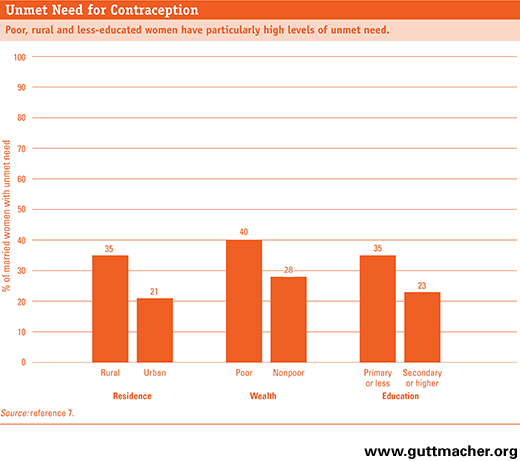
Action is needed to end unsafe abortion and reduce maternal mortality
Updated estimates of the incidence of unsafe abortion and its consequences are needed to assess trends and progress since 2003, the year of the most recent estimates. The existing evidence highlights several steps that policymakers can take now.
• Reduce unmet need for contraception by eliminating barriers to family planning services. The government should ensure that free or affordable public-sector contraceptive services reach all women, especially those who are poor and young. Programs should offer comprehensive family planning services—that is, provide counseling, information and a wide range of contraceptive methods—to enable women to choose the best methods for themselves, to use methods effectively and to switch methods when desired.
• Expand and improve the quality of postabortion care services. Because unsafe abortion continues to cause serious health complications, postabortion care will remain a vital part of maternal healthcare. More providers, including midlevel ones, must be trained in comprehensive postabortion care (particularly provision of manual vacuum aspiration) to adequately address the need for services in all parts of the country. Sensitivity training of providers is also needed.
• Emphasize the importance of youth-friendly services that offer confidential reproductive health counseling and information as well as provision of family planning methods.
• Improve health care providers’ ability to offer abortion services within the current legal context. It is critical to raise providers’ awareness of the content and scope of the Ugandan abortion law and to equip them with appropriate training to provide safe abortion services within legally permitted circumstances.
Implementation of these and similar measures would help reduce the toll of unintended pregnancy and unsafe abortion, and provide Ugandan women with the information they need to make the best decisions for their own well-being as well as that of their families.
REFERENCES
1. World Bank, Uganda, no date, <http://data.worldbank.org/country/Uganda>, accessed Nov. 10, 2012.
2. United Nations, World Population Prospects: The 2010 revision, New York: United Nations, 2010, <http://esa.un.org/wpp>, accessed Oct. 4, 2012.
3. Central Intelligence Agency, The world factbook: Uganda, 2012, accessed Nov. 10, 2012.
4. Tacoli C, Urbanization, gender and urban poverty: paid work and unpaid carework in the city, Urbanization and Emerging Population Issues Working Paper, London: International Institute for Environment and Development; and New York: United Nations Population Fund, 2012, No. 7.
5. Kinfu Y et al., The health worker shortage in Africa: Are enough physicians and nurses being trained? Bulletin of the World Health Organization, 2009, 87(3):225–230. <http://dx.doi.org/10.2471/BLT.08.051599>
6. Vlassoff M et al., Benefits of meeting the contraceptive needs of Ugandan women, In Brief, New York: Guttmacher Institute, 2009, No. 4. <http://www.guttmacher.org/pubs/IB_Contraceptive-Needs-Uganda.pdf>
7. Uganda Bureau of Statistics (UBOS) and ICF International, Uganda Demographic and Health Survey 2011, Kampala, Uganda: UBOS; and Calverton, MD, USA: ICF International, 2012.
8. Measure DHS, STATcompiler, no date, <http://statcompiler.com>, accessed Dec. 31, 2012.
9. Campbell M, Sahin-Hodoglugil NN and Potts M, Barriers to fertility regulation: a review of the literature, Studies in Family Planning, 2006, 37(2):87–98. <http://dx.doi.org/10.1111/j.1728-4465.2006.00088.x>
10. Ybarra ML et al., Prevalence rates of sexual coercion victimization and perpetration among Uganda adolescents, AIDS Care, 2012, 24(11):1392–1400. <http://dx.doi.org/10.1080/09540121.2011.648604>
11. Polis CB et al., Coerced sexual debut and lifetime abortion attempts among women in Rakai, Uganda, International Journal of Gynaecology & Obstetrics, 2009, 104(2):105–109. <http://dx.doi.org/10.1016/j.ijgo.2008.10.002>
12. Kaye DK, Community perceptions and experiences of domestic violence and induced abortion in Wakiso District, Uganda, Qualitative Health Research, 2006, 16(8):1120–1128. <http://dx.doi.org/10.1177/1049732306292172>
13. Wallace A, Adolescent pregnancy and policy responses in Uganda, Africa Portal Backgrounder, Ontario, Canada: Centre for International Governance Innovation, 2011, No. 14.
14. Center for Reproductive Rights (CRR), 10 key points about Uganda’s laws and policies on termination of pregnancy, Fact Sheet, New York: CRR, 2011.
15. Singh S et al., The incidence of induced abortion in Uganda, International Family Planning Perspectives, 2005, 31(4):183–191. <http://dx.doi.org/10.1363/3118305>
16. World Health Organization (WHO), Unsafe Abortion: Global and Regional Estimates of the Incidence of Unsafe Abortion and Associated Mortality in 2008, sixth ed., Geneva: WHO, 2011.
17. Prada E et al., Abortion and postabortion care in Uganda: a report from health care professionals and health facilities, Occasional Report, New York: The Alan Guttmacher Institute, 2005, No. 17. <http://www.guttmacher.org/pubs/2005/05/28/or17.pdf>
18. Jagwe-Wadda G, Moore AM and Woog V, Abortion morbidity in Uganda: evidence from two communities, Occasional Report, New York: Guttmacher Institute, 2006, No. 26. <http://www.guttmacher.org/pubs/or26.pdf>
19. Moore M, Jagwe-Wadda G and Bankole A, Men’s attitudes about abortion in Uganda, Journal of Biosocial Science, 2011, 43(1):31–45. <http://dx.doi.org/10.1017/S0021932010000507>
20. Moore AM, Kibombo R and Cats-Baril D, Ugandan policymakers’ knowledge and perceptions of unsafe abortion, paper presented at the Sixth African Population Conference, Ouagadougou, Burkina Faso, Dec. 5–9, 2011.
21. WHO, Trends in Maternal Mortality: 1990 to 2010, Geneva: WHO, 2012.
22. Inter-Parliamentary Union and Parliament of the Republic of Uganda, Maternal and child health: Uganda, 2011, <http://www.who.int/pmnch/media/membernews/ 2011/ugandabackgroundpaper.pdf>, accessed Nov. 10, 2012.
23. Mirembe F and Okong P, Risk factors associated with maternal mortality in three Kampala hospitals, unpublished report, Kampala, Uganda: Department of Obstetrics and Gynecology, Makerere University, 1995.
24. CRR, Abortion and the law in Uganda, Q&A, New York: CRR, 2012.
25. WHO, World Health Statistics 2012, Geneva: WHO, 2012.
26. Leahy E and Akitobi E, A Case Study of Reproductive Health Supplies, Washington, DC: Population Action International, 2009.
27. Vlassoff M et al., The health system cost of post-abortion care in Uganda, Health Policy and Planning, 2012, <http://heapol.oxfordjournals.org/content/early/2012/12/28/heapol.czs133.full.pdf+html>, accessed Jan. 16, 2013.
28. Babigumira J et al., Estimating the costs of induced abortion in Uganda: A a model-based analysis, BMC Public Health, 2011, Vol. 11, Art. 904, <http://www.ncbi.nlm.nih.gov/pmc/articles/PMC3293098>, accessed Jan. 8, 2013.
29. CRR, A technical guide to understanding the legal and policy framework on termination of pregnancy in Uganda, Briefing Paper, New York: CRR, 2012.
30. Westoff C, Unmet need for modern contraceptives methods, DHS Analytical Studies, Calverton, MD: ICF International, 2012, No. 28.
31. Babigumira JB et al., Potential cost-effectiveness of universal access to modern contraceptives in Uganda, PLoS ONE, 2012, 7(2):e30735, <http://www.ncbi.nlm.nih.gov/pmc/articles/PMC3281877>, accessed Jan. 8, 2013.
32. Karra M and Gribble J, Costs of induced abortion and cost-effectiveness of universal access to modern contraceptives, Research Brief, New York: Population Reference Bureau, 2012.
CREDITS
This In Brief was written by Rubina Hussain and edited by Peter Doskoch of the Guttmacher Institute. The author is grateful for the comments provided on the draft by Lynn M. Atuyambe, Charles Kiggundu and Florence Mirembe, all of Makerere University; Frederick Mugisha, Economic Policy Research Centre, Kampala; and Joseph Babigumira, University of Washington. The author would also like to acknowledge the contribution of the following colleagues: Akinrinola Bankole, Jessica Malter, Ann Moore, Susheela Singh, Gustavo Suárez and Michael Vlassoff, all of the Guttmacher Institute.
Hussain R, Unintended pregnancy and abortion in Uganda, In Brief, New York: Guttmacher Institute, 2013, No 2. <http://www.guttmacher.org/pubs/IB-Unintended-Pregnancy-Uganda.
Suggested Citation
Hussain R, Unintended pregnancy and abortion in Uganda, In Brief, New York: Guttmacher Institute, 2013, No 2. <http://www.guttmacher.org/pubs/IB-Unintended-Pregnancy-Uganda>
Topic
Supporting Resources
This report is accompanied by two fact sheets and a news release.
